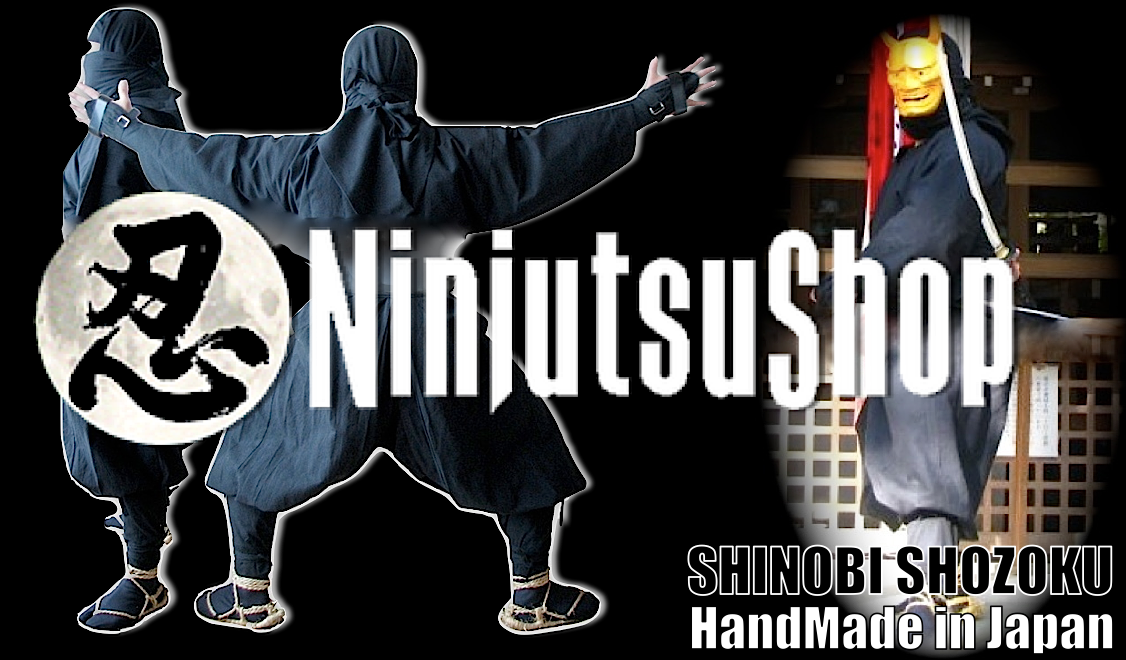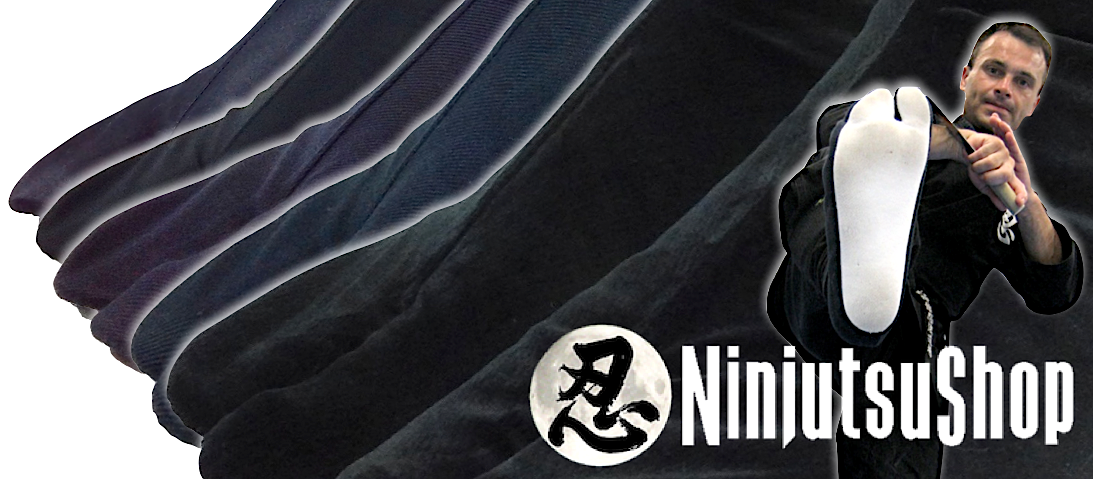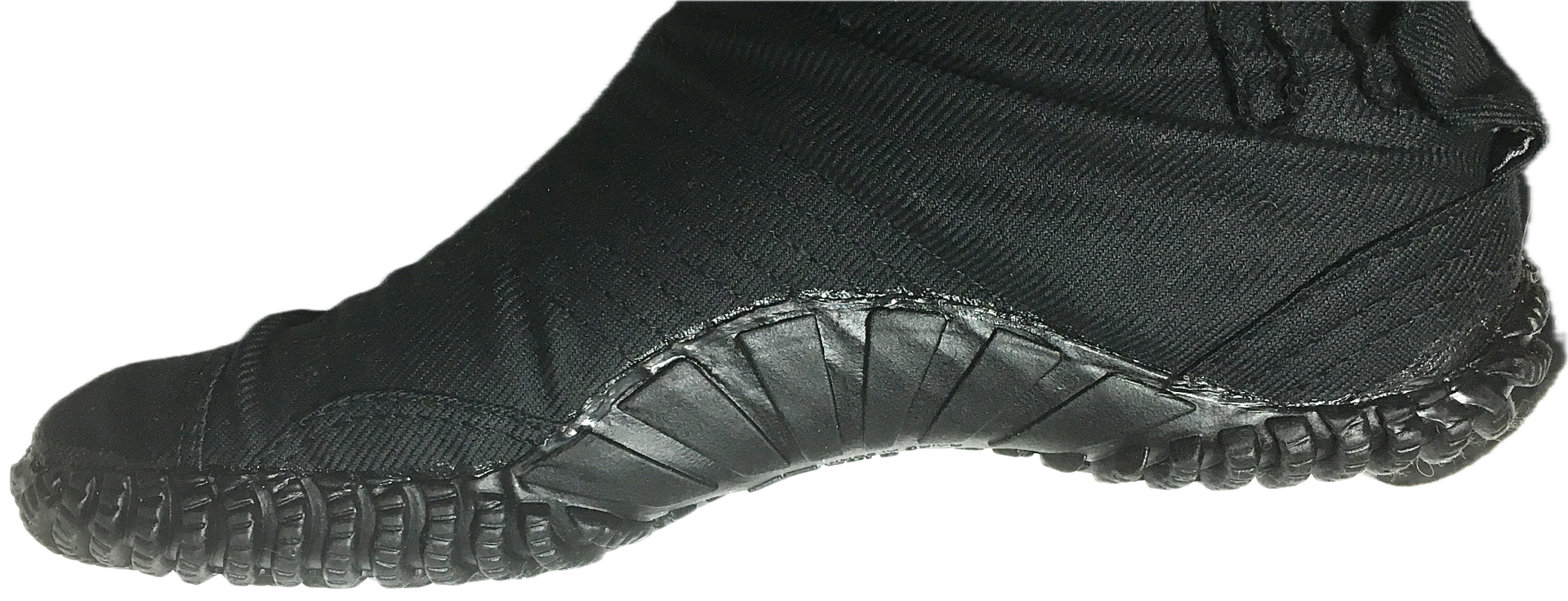Complete Guide to the Shinobi Shōzoku
How to Choose Your Traditional Ninja Uniform "Shinobi Shozoku " ?
Complete Guide to the Shinobi Shōzoku 忍び装束
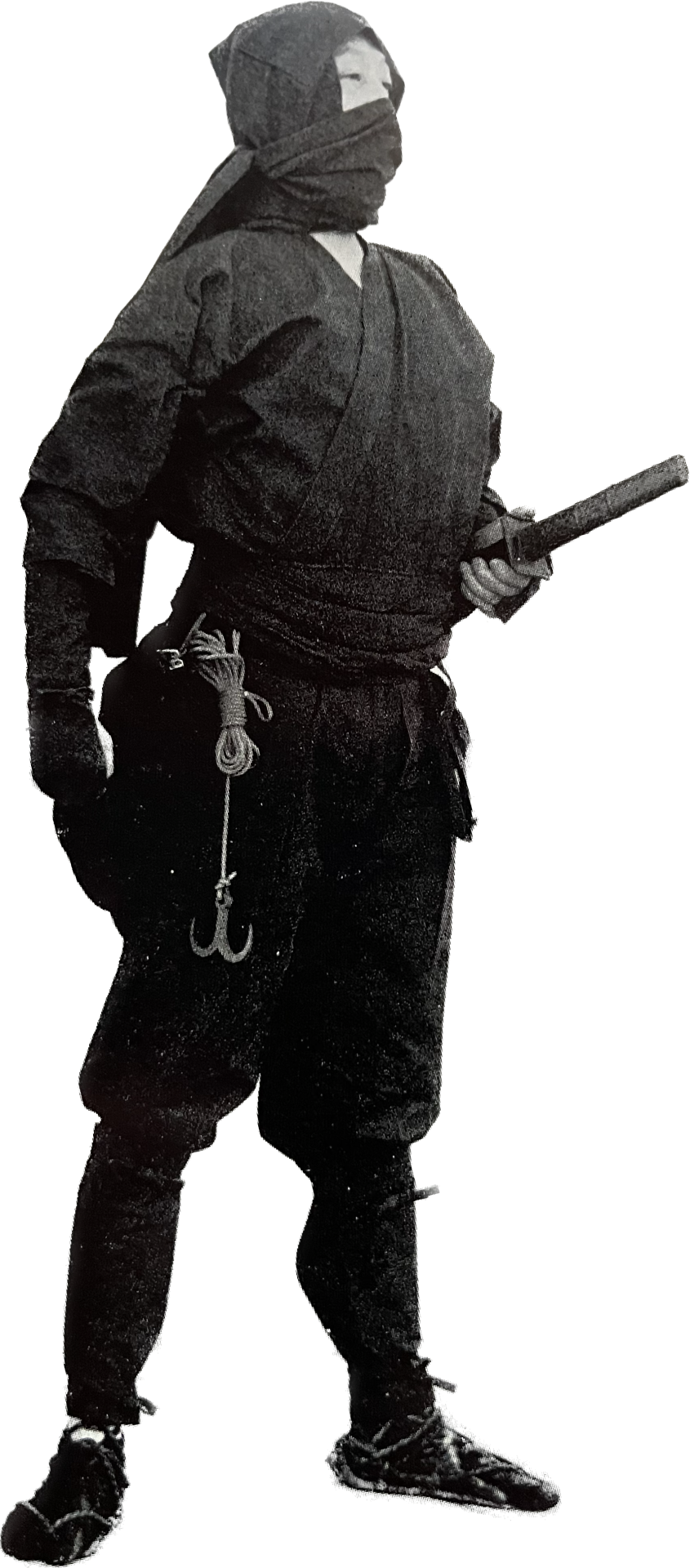 1. Introduction: What Is the Shinobi Shōzoku?
1. Introduction: What Is the Shinobi Shōzoku?
The Shinobi Shōzoku (忍び装束) is the traditional attire worn by shinobi, or ninjas, in feudal Japan. While it is commonly imagined as an all-black outfit, the historical reality is more complex. The Shinobi Shōzoku was a modular, functional clothing system designed to enhance stealth, mobility, and adaptability during espionage, infiltration, or combat missions.
This guide explores the complete anatomy of the ninja uniform — from each garment and its purpose, to the dyes used, hidden features, disguise techniques, and modern interpretations for martial arts practitioners.
2. Components of the Traditional Ninja Outfit
(上衣) Uwagi
The foundational clothing, typically a top made of thick, durable cotton or hemp. It was cut for unrestricted movement, reinforced at stress points, and stitched with minimal external seams to reduce noise and friction.
Hidden pockets or shoulder pouches
(忍び六具 : Shinobi Rokugu):
→ Pockets or bags for ninja tools such as shuriken, senban, shuko, etc.
(鎖帷子) Kusari Katabira (optional) :
→ Chainmail armor worn under or over clothing.
(覆面) Fukumen (Face Mask) and (頭巾) Zukin (Hood)
The fukumen covers the lower face (from the nose to below the chin) while the zukin conceals the head, neck, and occasionally shoulders. These components shield the ninja's identity and prevent light reflection on exposed skin.
(手甲) Tekko (Forearm Guards)
Worn over the forearms, tekko were reinforced with cloth or leather. Some included sewn-in mesh or compartments for shuriken or powders.
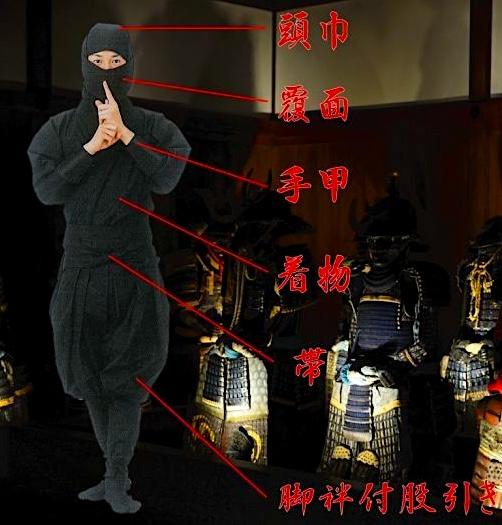 (脚絆) Kyahan (Leg Wraps)
(脚絆) Kyahan (Leg Wraps)
Tied around the calves, kyahan secured the pants and reduced flapping fabric. They provided some protection and helped silence movement through undergrowth or rocky terrain.
(帯) Obi (Belt)
More than just a waist tie, the obi served as a weapon and tool harness. It could carry kunai, smoke bombs, and compact rope coils discreetly around the waist.
(立毛袴) Tatsuke-bakama (Modified Hakama)
These trousers were tighter than standard hakama and were bound below the knees. Used in rugged environments for mobility and reduced entanglement.
(帯) Tabi (Split-toe Socks) and (帯) Waraji (Straw Sandals)
Worn together, tabi and waraji allowed for silent and nimble movement across uneven surfaces. Tabi were made from cotton, and waraji were straw-soled with lace-up closures.
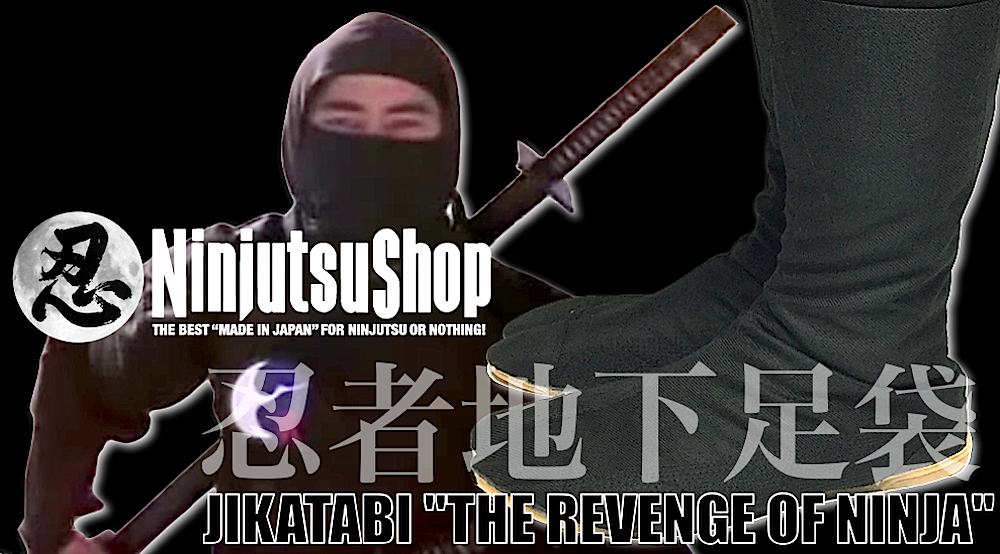
3. Jikatabi: Modern Footwear, Not Historical
Jikatabi (rubber-soled tabi boots) are widely used today in martial arts and outdoor settings. However, they were not worn by historical ninjas. Created in the 20th century, they offer grip and durability, but traditionalists prefer tabi with waraji for authenticity and quiet movement.
4. Natural Dyes and Camouflage Colors
The stereotype of a pure black ninja outfit comes from theater and pop culture. Historically, shinobi used natural dyes to create earth-tone garments that blended into the environment under moonlight or torchlight. Black was rarely used because it actually stood out in the dark.
| Color | Dye Source | Japanese Name | Primary Use |
|---|---|---|---|
| Charcoal Gray | Pine soot | Sumi-iro (墨色) | Urban environments |
| Indigo Blue | Persicaria tinctoria | Aizome (藍染) | Night, forested areas |
| Earth Brown | Fermented unripe persimmon | Kakishibu (柿渋) | Fields and rural areas |
| Olive Green | Mountain herbs and bark | Yamagusa (山草) | Woodlands and hills |
5. Craftsmanship and Functional Finishing
Every piece of the Shinobi Shōzoku was designed for silence, durability, and discretion. Here are key functional and craftsmanship features that defined the authentic ninja uniform:
- Inverted internal stitching: prevented snagging on branches and reduced skin irritation from seams.
- Reinforced stress points: elbows, knees, shoulders were often double-layered with extra fabric or soft leather.
- Fabric closures: no visible metal buttons or fasteners. Closures were made using fabric cords, sashes, or concealed folding techniques.
- Matte, noise-resistant fabrics: tightly woven cotton or cotton-linen blends were used to avoid light reflection and reduce noise when moving.
- Modular design: some garments had detachable sleeves or adjustable trousers for different mission types or weather conditions.
6. Weapon and Tool Integration
The Shinobi Shōzoku was more than clothing – it was a tactical framework for carrying and deploying essential ninja tools. These were subtly incorporated into the outfit and easily accessible during movement:
- Shuriken (throwing stars): stored in sleeve cuffs, belt, or tekko (forearm guards).
- Kunai (dagger/multi-tool): slipped into the obi or strapped across the back.
- Fukiya (blowgun): hidden in a sleeve or back compartment.
- Kaginawa (grappling hook with rope): wrapped around the waist or stored in a side pouch.
- Shuko & Ashiko (hand and foot claws): strapped to forearms or calves for climbing and defense.
- Shinobi Rokugu ("six ninja tools"): compact utility set (fire powder, lamp, cords, metal hook, etc.) stored in hidden pouches.
Ninjas were trained to deploy tools quietly, even from crouched or prone positions. The outfit was carefully constructed to avoid restricting movement or creating noise when accessing equipment.
7. Symbolism and Philosophy of the Outfit
Beyond function, the Shinobi Shōzoku embodied the spiritual and philosophical values of the Ninpō tradition. Each part of the clothing reflected a mindset:
- Discretion: the outfit was designed to avoid attention, not to impress.
- Adaptability: garments were interchangeable, adjustable, and mission-specific.
- Neutrality: sober colors and minimalist designs reflected the idea of mu (無) – emptiness, self-erasure.
- Environmental fusion: the ninja’s clothing helped them become part of the landscape, physically and psychologically.
Wearing the Shinobi Shōzoku was not just about appearance — it was about entering a state of heightened awareness, humility, and readiness.
8. Regional and School Variations
The ninja uniform was not standardized across all clans. It varied significantly depending on the region, the school (ryūha), and the mission environment:
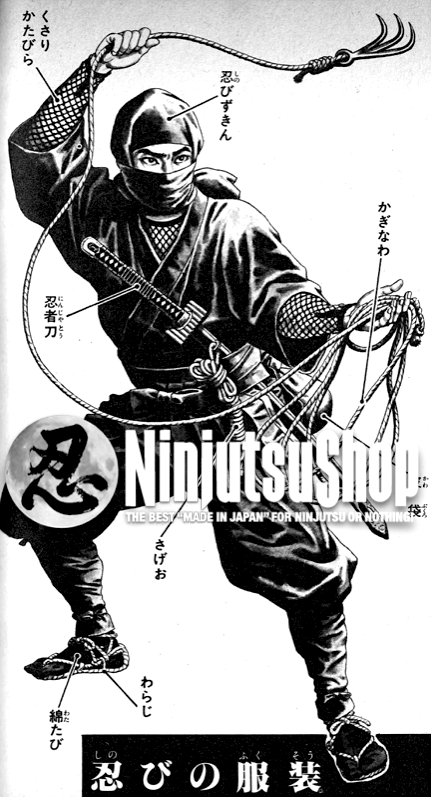 Iga Ryū
Iga Ryū
- Relied on peasant-style clothing to blend into rural surroundings.
- Used earth-tone dyes: brown, olive, stone gray.
- Materials were often rough and intentionally worn to appear ordinary.
Kōga Ryū
- Masters of disguise (see Hensō-jutsu in Part 3).
- Disguises included merchants, monks, and wandering ascetics.
- Outfits were deliberately unremarkable, allowing easy infiltration.
Togakure Ryū
- Favored the tatsuke-bakama for stealth and mobility in mountainous terrain.
- Dark indigo or black attire, minimal external markings.
- Some garments included hidden internal armor (chainmail, leather).
9. Modern Use of the Shinobi Shōzoku
Today, the Shinobi Shōzoku is worn in a variety of modern contexts that preserve and reinterpret the ninja heritage. While it is no longer used for covert operations, it remains a powerful symbol in martial arts, cultural education, and entertainment.
Martial Arts and Ninjutsu Practice
- Used in dojos affiliated with schools such as Bujinkan, Genbukan, Jinenkan, and independent Togakure Ryū groups.
- Functional designs are prioritized — durability, flexibility, and practicality are more important than theatrical aesthetics.
Public Demonstrations and Events
- Martial arts exhibitions, taikai (gatherings), and festivals often feature Shinobi Shōzoku in use during live performances or kata demonstrations.
- Some practitioners wear the uniform at historical reenactments or lectures about ninja culture.
Tourism and Pop Culture
- In Japan, ninja theme parks (e.g., Iga Ninja Museum, Edo Wonderland) feature actors in historically inspired Shinobi Shōzoku outfits.
- Costume interpretations vary — from authentic reproductions to pop-anime versions inspired by manga and video games.
10. How to Choose a Quality Shinobi Shōzoku
Whether you're training, performing, or studying ninjutsu, selecting the right outfit is essential. Here’s how to identify a quality Shinobi Shōzoku:
What to Avoid
- Cheap costume sets made of shiny polyester or satin.
- Loose or non-reinforced seams that may rip during movement.
- Inaccurate historical designs (zippers, velcro, plastic armor).
What to Look For
- Durable, breathable fabrics like heavy cotton or cotton-linen blend.
- Matte finish (non-reflective), preferably hand-dyed or traditionally dyed.
- Hidden pockets or tool loops for weapons or accessories.
- Proper sizing with adjustable features (belt, ties, leg closures).
Recommended retailers: Look for stores run by experienced ninjutsu practitioners.
One such option is NinjutsuShop.com, which offers functional uniforms tested in actual martial arts practice.
11. Care and Durability
A properly maintained Shinobi Shōzoku can last many years, even under frequent training conditions. Here are best practices for care and preservation:
- Washing: Use cold water and mild natural soap. Hand-washing is ideal, or use a delicate cycle.
- Drying: Air-dry in the shade. Direct sunlight may fade natural dyes over time.
- Storage: Fold neatly and store in a dry, cool place. Avoid plastic bags which trap moisture.
- Inspection: Periodically check seams, cords, and closures. Reinforce or replace when worn.
12. Final Conclusion
The Shinobi Shōzoku is more than just a costume. It represents centuries of refined martial knowledge, strategic thinking, and cultural wisdom. Whether worn for training, education, or artistic performance, understanding its true purpose elevates its meaning beyond appearance.
As you put on the Shinobi Shōzoku, you are not only dressing like a ninja — you are stepping into a tradition of mastery, humility, and transformation.
Explore Our Authentic Shinobi Shōzoku 忍び装束 Collection
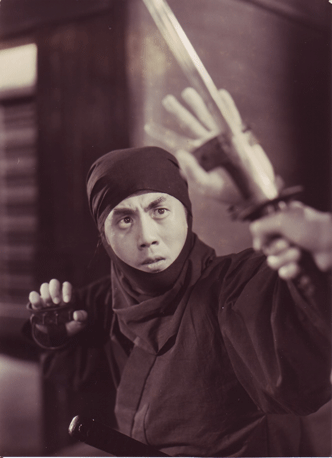 Are you passionate about traditional Ninjutsu and seeking a ninja uniform faithful to the legacy of Japan’s legendary shinobi? Discover our exclusive Shinobi Shōzoku collection — authentic, handcrafted, and shipped directly from Kyoto:
Are you passionate about traditional Ninjutsu and seeking a ninja uniform faithful to the legacy of Japan’s legendary shinobi? Discover our exclusive Shinobi Shōzoku collection — authentic, handcrafted, and shipped directly from Kyoto:
Browse the full Shinobi Shōzoku Ninja Uniform Collection
Each set includes:
- A traditional jacket Uwagi (上着)
- Wide combat pants Tatsuke Bakama (たつけばかま)
- Leg wraps Kyahan (脚絆)
- An integrated obi belt
- A Fukumen (覆面) face mask
- A Zukin (頭巾) hood
- A pair of hand guards Tekkō (鉄甲)
Complete Your Outfit with Ninja Tabi & Jikatabi Shoes
Authentic ninja footwear is essential for stealth, agility, and comfort — indoors and outdoors.
Ninja Tabi Socks — flexible, lightweight, traditional
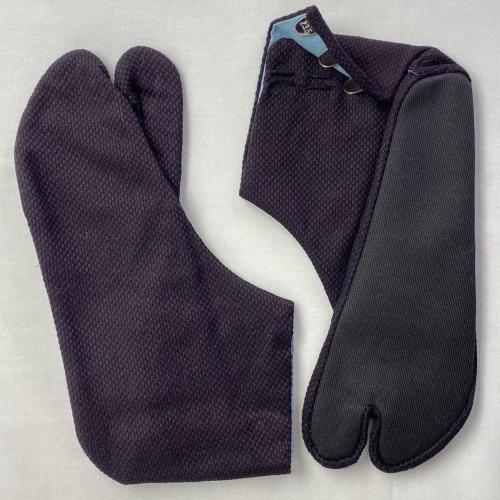 Inspired by classical Japanese theatre and martial arts, our ninja tabi socks offer discreet comfort and foot freedom, enhancing agility and balance whether you’re training, meditating, or simply walking in harmony with tradition. Available in black or indigo blue, in cotton or polyester fabric, they are perfectly suited for both dojo practice and outdoor use, especially when worn with a pair of waraji.
Inspired by classical Japanese theatre and martial arts, our ninja tabi socks offer discreet comfort and foot freedom, enhancing agility and balance whether you’re training, meditating, or simply walking in harmony with tradition. Available in black or indigo blue, in cotton or polyester fabric, they are perfectly suited for both dojo practice and outdoor use, especially when worn with a pair of waraji.
Explore our Tabi Socks Collection for Ninjutsu
- Perfect for indoor training and exhibitions
- Traditional split-toe design
- Lightweight, silent, and minimalist
Jikatabi Ninja Shoes — modern, reinforced for outdoor practice
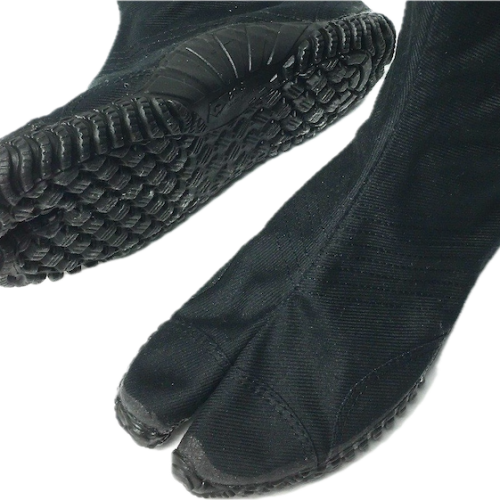 Our Jikatabi are designed for rigorous outdoor Ninjutsu training: excellent grip, mobility, and foot protection. Crafted with durable soles and flexible materials, they ensure silent movement, enhanced stability, and natural foot alignment — essential for stealth, speed, and precision in every step.
Our Jikatabi are designed for rigorous outdoor Ninjutsu training: excellent grip, mobility, and foot protection. Crafted with durable soles and flexible materials, they ensure silent movement, enhanced stability, and natural foot alignment — essential for stealth, speed, and precision in every step.
Available in black and various traditional colors, in all sizes, with both low and high-cut designs. Choose from 3 to 15 kohaze fastenings to suit your level and training needs. Their non-slip soles are perfectly adapted for all terrains — ideal for walking, running, climbing, and tree-scaling techniques such as Shōten no Jutsu (昇転の術). Pair them seamlessly with your Shinobi Shōzoku for an authentic and functional ninja outfit
View the Full Jikatabi Ninja Shoes Collection
- Durable rubber soles for uneven terrains
- Available in multiple models and sizes
- Ideal for forest runs, rooftop training, and daily use
Recommended For:
- Dedicated practitioners of Togakure Ryū Ninpō 戸隠流忍法
- Martial arts demonstrations and serious training
- Traditional cosplay and historical re-enactments
- Spiritual immersion and meditative walks in nature
⚠️ Please note: Our items are handcrafted in limited quantities. Each product is carefully inspected before shipping from Kyoto.
➡️ Order your Shinobi Shōzoku, Tabi Socks, and Jikatabi Shoes today — and walk the true path of the shadow warrior.
Add a comment

